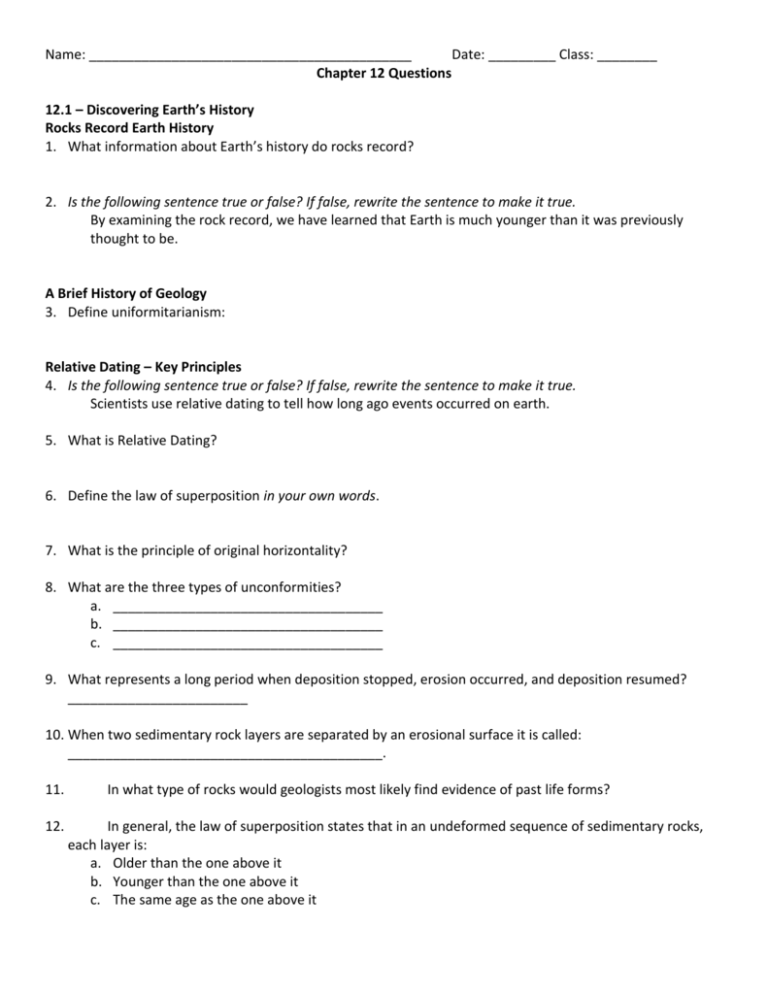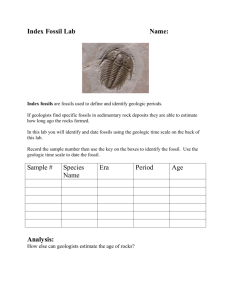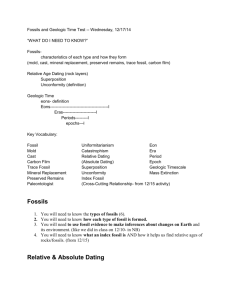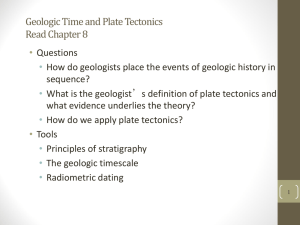Name: ______ Date: ______ Class: ______ Chapter 12 Questions
advertisement

Name: ___________________________________________ Date: _________ Class: ________ Chapter 12 Questions 12.1 – Discovering Earth’s History Rocks Record Earth History 1. What information about Earth’s history do rocks record? 2. Is the following sentence true or false? If false, rewrite the sentence to make it true. By examining the rock record, we have learned that Earth is much younger than it was previously thought to be. A Brief History of Geology 3. Define uniformitarianism: Relative Dating – Key Principles 4. Is the following sentence true or false? If false, rewrite the sentence to make it true. Scientists use relative dating to tell how long ago events occurred on earth. 5. What is Relative Dating? 6. Define the law of superposition in your own words. 7. What is the principle of original horizontality? 8. What are the three types of unconformities? a. ____________________________________ b. ____________________________________ c. ____________________________________ 9. What represents a long period when deposition stopped, erosion occurred, and deposition resumed? ________________________ 10. When two sedimentary rock layers are separated by an erosional surface it is called: __________________________________________. 11. 12. In what type of rocks would geologists most likely find evidence of past life forms? In general, the law of superposition states that in an undeformed sequence of sedimentary rocks, each layer is: a. Older than the one above it b. Younger than the one above it c. The same age as the one above it Name: ___________________________________________ Date: _________ Class: ________ 13. Use the following figure to complete each sentence comparing the relative ages of the features. Where indicated, identify the law or principle you used to arrive at your answer. a. Dike B is ______________________ than fault B. Law or principle: ________________________________ b. The shale is ______________________ than the sandstone. Law or principle: _______________________ c. Dike B is ______________________ than the batholiths. Law or principle: __________________________ d. The sandstone is______________________ than Dike A. Law or principle: __________________________ e. The conglomerate is ______________________ than the shale. Law or principle: ____________________ Correlation of Rock Layers 14. What is the matching up of rocks of similar age in different regions? a. Correlation b. Superposition c. Uniformitarianism d. Unconformity 12.2 Fossils: Evidence of Past Life 1. What are fossils? 2. The footprints of a dinosaur are an example of what type of fossil? 3. In which type of rocks are fossils found? Fossil Formation 4. Under what condition the organism died and how the organism was ___________________ determine the type of a fossil the organism will form. 5. What type of fossil is formed when an organism is buried in sediment and then dissolved by underground water? Fossil Correlation 6. What are index fossils? Name: ___________________________________________ Date: _________ Class: ________ 7. True or false: Scientists use fossils to interpret and describe ancient environments. 12.4 – Geologic Time 1. What is the geologic time scale? 2. What length of time does the geologic time scale cover? 3. Complete the following flowchart with the types of subdivisions of the geologic time scale, from longest to shortest expanse of time: Longest: Shortest: 4. The eon called the __________________________________ began about 540 million years ago. 5. The era of “ancient life” is known as the _________________________. 12.3 Dating with Radioactivity 1. Define radioactivity: 2. Define a half-life: Use the graph to answer the questions on the following page: Name: ___________________________________________ Date: _________ Class: ________ 3. How much of the parent material is left after 1 half life? 4. How much of the parent material is left after 2 half lives? 5. If 1/32 of the parent material remains, how many half lives have passed? 6. If 1/16 of the parent material remains, how many half lives have passed? 7. A sample is brought to the laboratory and it is determined that one-eighth of the original parent isotope remains in the sample. Use the graph to determine the age of the sample if the half-life of the material is 60 million years. 8. If the half-life of an unstable isotope is 10,000 years, and only 1/8 of the radioactive parent remains in a sample, how old is the sample? Name: ___________________________________________ Date: _________ Class: ________ Chapter 13 Questions Use Chapter 13 in your books to answer the following questions. After you finish, continue working on the Geologic Time Scale Project. These are due by the end of class today. 1. What is the major source of free oxygen in the atmosphere? 2. How far back does the fossil record extend? 3. What length of time does the geologic time scale cover? 4. The largest expanse of time on the geologic time scale is what? 5. The era of “ancient life” is known as what? 6. What is the major source of free oxygen in the atmosphere? 7. How far back does the fossil record extend? 8. What happened to all the continents by the close of the Paleozoic? 9. In the early Paleozoic, life was restricted to where? 10. During the Pennsylvanian period, large tropical swamps extended across North America, eventually forming what? 11. What event may have triggered the great Paleozoic extinction? 12. What were the first true terrestrial animals? 13. Why did many plants die at the end of the Mesozoic? 14. What caused many events of mountain building, volcanism, and earthquakes in western North America during the Cenozoic? 15. Which title best describes the current geologic age? 16. Mammals became dominant only after what major event?








